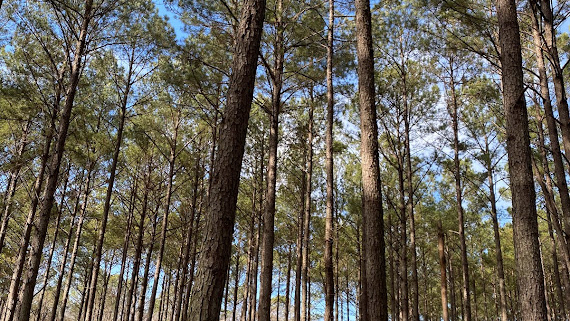The Nature of Forest Equity
I normally write about The Nature of a specific wild place either here in Alabama or wherever travel may take me. View this Post as a compendium of observations, reflections, and photographs (ond one video) assembled from my forest ventures in diverse wildland settings around a contemporary theme. I have devoted my life as a forest scientist to forest systems study and observation. I focus this post on my observations revealing the absence of equity in Nature. Instead, Nature is a tireless meritocracy; Nature is ruthlessly competitive.
Role of Equity in Forests
We hear so much today about a term that seems to overwhelm politics, media, higher education, and even dinnertime conversation: equity. We hear the theme emerge as some reflect that we humans are not separate from Nature…but instead are one with our natural environment. Some stretch that connection to conclude that our human relationships…social, economic, and political…can be modeled after natural interactions (including equity) among life forms, and which define natural ecology and ecosystem function. Some people view equity as a construct derived from Nature and ubiquitous within natural systems. Merriam-Webster defines equity as: justice according to natural law or right; freedom from bias or favoritism. A common simple meaning I’ve heard for equity in human society, business, and organizations is equal outcome.
I see no evidence in Nature that equity (equal outcome) is central to forest systems (or, for that matter, any natural system). I have devoted my life as a forest scientist to forest systems study and observation. I focus this post on my observations revealing the absence of equity in Nature. Instead, Nature is a tireless meritocracy. Nature is ruthlessly competitive. Leonardo da Vinci recognized 500 years ago Nature’s brutal reliance on the strong surviving:
Nature appears to have been the cruel stepmother rather than the mother of many animals.
My September 2021 Post posited Nature as a meritocracy: https://stevejonesgbh.com/2021/09/21/lessons-from-nature-nature-is-a-meritocracy/
I offer a series of examples in this Post drawing primarily from my relevant prior photo-essays. I excerpted this first example from my October 14, 2021 photo-essay: Heart’s Content in NW Pennsylvania (Part One): https://stevejonesgbh.com/2021/10/14/hearts-content-in-nw-pennsylvania-part-one/
Ninety Years of Allegheny Hardwood Forest Renewal: An Absolute Refutation of Equity
Wisely, US Forest Service researchers began a long-term monitoring study on the Tionesta Scenic and Research Natural Area, Allegheny National Forest, in 1928. Note: the entire photo sequence is courtesy of the US Forest Service (Copyright USFS). The forest scientists arranged and oversaw timber harvesting on an old growth forest that year. Cutting was in progress below left. The image below right (1929), taken from the same photo point at exactly the same angle, shows the site at the end of the first growing season post-harvest. Note the proliferation of young seedlings and sprouts.
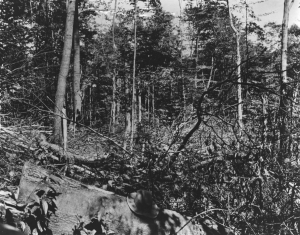
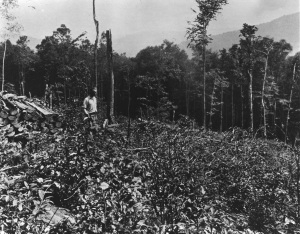
At ages ten and twenty (1937 and 1947) the tens of thousands of stems per acre is transitioning from a nearly impenetrable thicket to a stand of saplings with spacing sufficient for a forester to walk through and measure individuals. I have said in prior Blog Posts that Nature is a meritocracy. The 1937 and 1947 survivors (I am estimating that less than five percent of the tree seedlings/sprouts in the 1929 stand remain at age 20) are stronger, faster growing individuals that simply outperformed those no longer extant. To the victors go the spoils. The competition occurs both within and between species. Affirmative action does not operate in natural systems. There are no offices of ecosystem equity to set quotas nor monitor diversity, inclusion, and equity. Species by species, Nature simply performs her relentless pursuit of sustainable growth and reproduction, generation to generation, among all living creatures…as she has operated for 3.7 billion years.
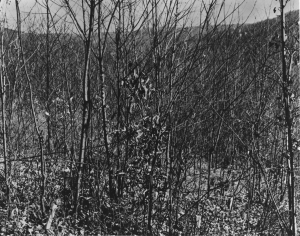
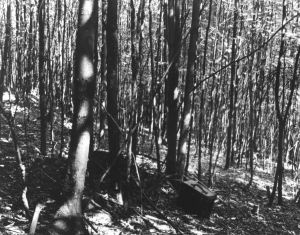
By ages 30 and 40 (1958 and 1968), the forest has changed remarkably, reaching a stage allowing us to more easily follow individual trees from one period to the next. Note the man standing to the left in the 1958 image. The large black cherry tree is reigning over its neighbors, capturing more and more site resources. There are those who today claim in pseudo-scientific mainstream publications that the forest is a community of interconnected, caring, and collaborating trees and associated organisms. I encourage readers to carefully study specific stems in this sequence over time. I see no evidence that the survivors give a rip about the stems falling behind, weakening, dying, and tipping to the forest floor.
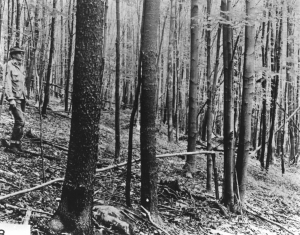
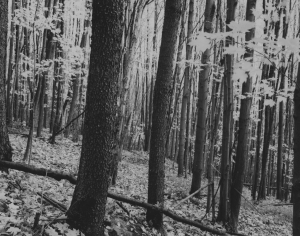
We are now at ages 56 and 60 (1984 and 1988). Our large black cherry continues to thrive; fewer and fewer stems remain. Our seedling thicket has reached a condition such that most casual hikers might think it an undisturbed forest.
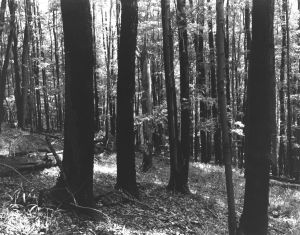
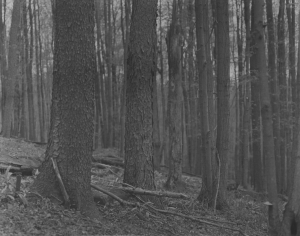
By ages 70 and 80 (1998 and 2008), our dominant cherry is a regal denizen, a magnificent leader of this second growth forest. Dead and down woody debris signals that competition remains fierce. Note that even the distant forest now reveals fewer and fewer stems per acre.
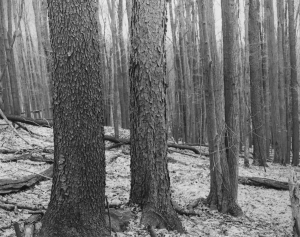
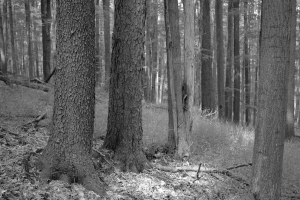
The most recent image (2018) shows a 90-year-old forest, one most observers would term mature. Striking a chord with me, these photos are a reminder that I conducted my doctoral research in 80-90-year-old second growth Allegheny hardwood stands, similar to this one, just 40-50 miles from Tionesta.
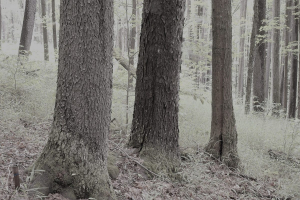
I add the following observation as postscript to my October 2021 narrative: Survivors after 90 years are the strong; to the victors go the spoils. Nature is a meritocracy.
Birch Regeneration at Maryland’s New Germany State Park
Excerpted from my November 29, 2021 photo-essay, Maryland’s New Germany State Park: Returning after 51 Years: (https://stevejonesgbh.com/2021/11/29/marylands-new-germany-state-park-returning-after-51-years/):
Below left a cluster of windthrown trees create a crown opening sufficient to allow sunlight to reach the ground, stimulating a thicket of birch regeneration. Below right a more recent windthrow opening will spark another patch of reproduction. The germinated birch seedlings, after just 3-5 years, are evidencing differential height. Only the strong will constitute the stand emerging from the opening. Over time, the forest will shift to a mosaic of small stands growing in scattered openings.
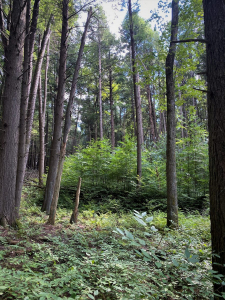
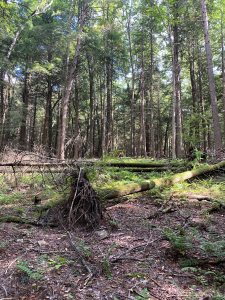
Today’s postscript to the prior photo-essay: Nature abhors a vacuum. In the case of these openings, the species and individuals best able to exploit the sunshine and newly available soil resources will prevail, prosper, and fill the void. Again, to the victors go the spoils.
Regenerating White Pine at Hickory Creek Wilderness
November 17, 2021 photo-essay, Pennsylvania’s Hickory Creek Wilderness: https://stevejonesgbh.com/2021/11/17/pennsylvanias-hickory-creek-wilderness/
I found an occasional white pine overstory tree. This individual stands as a dominant member of the main canopy. Unlike the barren (fern-covered) understory elsewhere, white pine regeneration (10-15-year-old saplings) offer promise within seed-fall radius of the mother tree. The regeneration, like the sweet birch in openings at New Germany, are developing at differential height growth rates. The strong will survive. Each individual has more or less equivalent opportunity. Equal outcomes (equity) are not guaranteed in the forest.
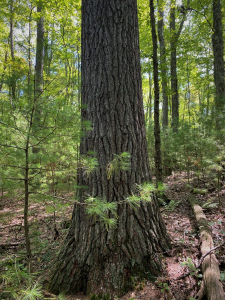
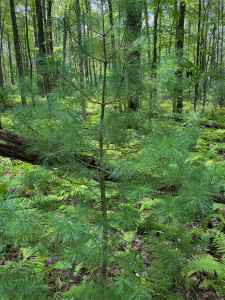
Nearby a small grove of hemlock likewise supports advanced hemlock regeneration. White pine and hemlock are shade tolerant when young, enabling advanced regeneration to patiently await crown openings or major forest disturbance.
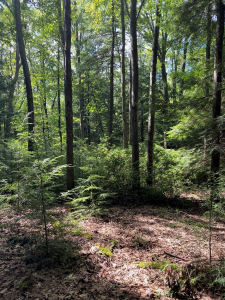
Postscript: Once again, only the strong survive in the natural world.
Natural Pine Stand along the Hiking and Biking Trail at WNWR
Here are photos and narrative from a draft photo-essay that I will publish during the first quarter of 2023:
Some former agricultural lands have regenerated to forest. This upland pine stand appears to be 12-15 years old. I saw no evidence of planting (trees in rows), yet all stems seemed to be the same age. Therefore, I believe the stand either regenerated naturally, yet I did not see an evident seed source, or perhaps originated from aerial- or tractor-dispensed seed? Converting some acreage from marginal cropland to native loblolly falls within the Refuge mission to provide diverse habitat for wildlife.
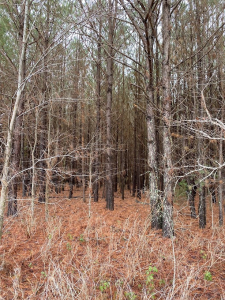
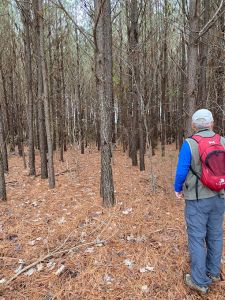
Postscript: The lesson that Darwin revealed operates across the temperate terrestrial plant communities of my familiarity, whether Allegheny Hardwoods or southern pines.
Chapman Mountain Nature Preserve Loblolly Pine
Excerpted from my September 22, 2022 photo-essay, Special Post for October 2022 PLT Training: https://stevejonesgbh.com/2022/09/22/special-post-for-october-2022-plt-training/
Across the parking lot from the trailheads, loblolly pine trees shelter the 18-hole disc golf course. The flat land had been tilled into the 1980s. Consulting forester Brian Bradley told me that a 1985 aerial photo shows the field still in crops. By the mid 1990s the field had seeded naturally to pine from nearby mature, seed-bearing loblolly. The pine captured the abandoned field effectively. There is very little understory of ground vegetation and brush, the effect enhanced by what Brian describes as a very good prescribed fire in 2018. There is no sub-canopy of hardwood saplings and poles. The stand is pure, even-aged loblolly pine. Some day I will extract an increment core to determine the exact year of establishment (i.e. age). Brian revealed that a reliable logger thinned the stand in 2014-15, giving it the current look of a well-tended planted stand with stems evenly distributed. Brian, when pressed to give me his best estimate for stand age, offered his answer of 32+/- years, an estimate I embrace wholeheartedly! We also agree that the main canopy averages 75 feet.
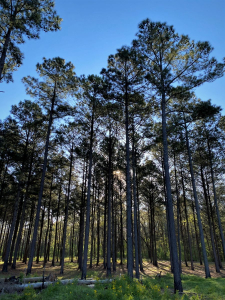
Rather than add a postscript, I revisited the trails nearby and through the old field pine stand January 24, 2023 to bring closure to this photo-essay.
A one-half mile trail passes north of the pine stand through a highway-edge forest, variously disturbed by construction activities. The 12-15 loblolly pine in the two photos below dropped seed to an acre of cleared land under the trees, in effect serving as a seed tree harvest for the disturbed soil. The seedlings appear to be 4-7 years old, the tallest of them exceeding head high. Height is variable, indicating intense competition and differential performance. Stronger individuals are racing ahead to capture an ever-greater share of sunlight and site resources.
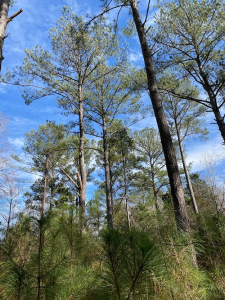
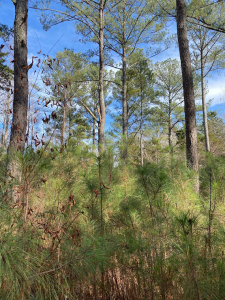
Stocking is dense, averaging two stems per square foot. That stocking equates to 86K stems per acre…extremely dense. Attrition through mortality is rapidly reducing stand density. This regenerating acre suggests the adjoining old field condition three decades ago, an agricultural site rapidly progressing from dense seedling cover to the forest now sheltering the disc golf course.
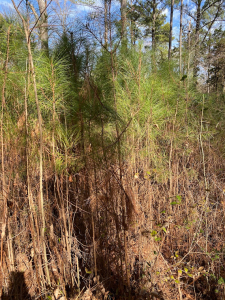
The untrained forestry eye may have difficulty visualizing the conversion and transformation. Remember, the journey has seen two thinning and at least one effective prescribed fire.

Evidence of thinning appears as cut stumps, visibly decaying, in both images. The stem at left shows a trunk charred from the prescribed fire. Loblolly is well adapted to a ground fire intense enough to scorch the bark to 6-8 feet.
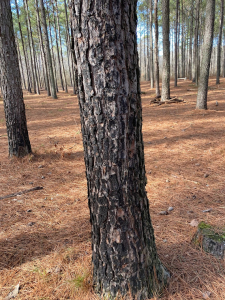
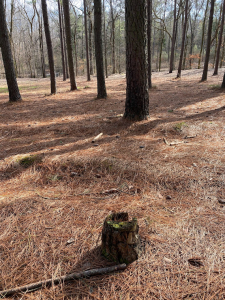
Trimmed tops lie adjacent to the tree at left. Below right, the ground near the stump is supporting seedlings sprouting within the thick pine straw.
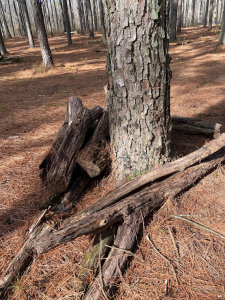
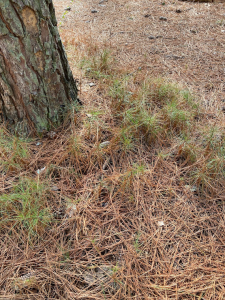
At the stand’s edge near the parking lot, residual from the prior thinning operation’s gathering yard (for loading logs onto trucks for transport), a small area that had seeded 2-3 years and escaped the most recent fire, is supporting 3-4 seedlings per square foot…perhaps 200,000 seedlings per acre. Nature relies heavily on the power of numbers. The greater the initial density, the more effectively competition enables the best to survive to dominance, ensuring reproductive supremacy and natural selection.
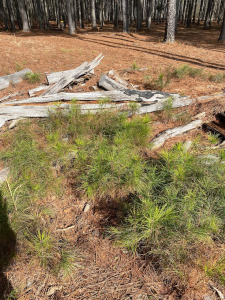
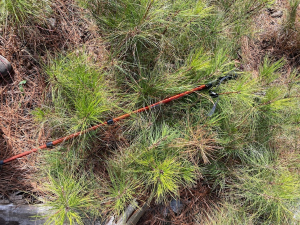
Within the stand I discovered a several-hundred-square-foot zone that the prescribed fire missed completely. Hardwood brush, some ten-feet-plus high, is capturing the area. Black locust a north Alabama pioneer species extraordinaire, is dominant and thriving (below right).
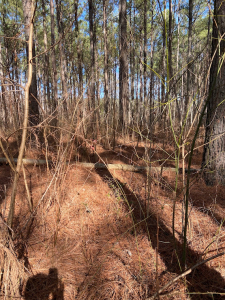
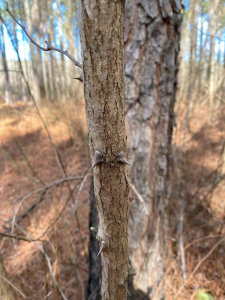
Nature is a master of regenerating our forests, especially when trained and educated foresters guide her direction. Foresters in this case manipulated species composition, stand density, and competing vegetation to achieve the park-like loblolly pine stand, perfectly suited to shelter a disc golf course. Foresters are ever mindful that equity does not operate in nature systems.
I recorded this 3:03 video within the pine stand to supplement the limited power of my words and still photos:
Einstein understood far more than merely quantum mechanics and mass energy equivalence. Of Nature, he observed:
Look deep into nature, and then you will understand everything better.
Summary: Diversity, Equity, and Inclusion in Natural Systems
Seminal Conclusion
Thoughts and Reflections
I offer these observations:
- Nature is a tireless meritocracy; to the victor go the spoils.
- Nature appears to have been the cruel stepmother rather than the mother of many animals. Leonardo da Vinci
- Performance, perseverance, and persistence matter in natural systems.
Inhale and absorb Nature’s elixir. May Nature Inspire, Inform, and Reward you!
Note: All blog post images created & photographed by Stephen B. Jones unless otherwise noted. Please circulate images with photo credit: “©2023 Steve Jones, Great Blue Heron LLC. All Rights Reserved.”
Another Note: If you came to this post via a Facebook posting or by an another route, please sign up now (no cost… no obligation) to receive my Blog Post email alerts: http://eepurl.com/cKLJdL
And a Third: I am available for Nature-Inspired Speaking, Writing, and Consulting — contact me at steve.jones.0524@gmail.com
Reminder of my Personal and Professional Purpose, Passion, and Cause
If only more of us viewed our precious environment through the filters I employ. If only my mission and vision could be multiplied untold orders of magnitude:
Mission: Employ writing and speaking to educate, inspire, and enable readers and listeners to understand, appreciate, and enjoy Nature… and accept and practice Earth Stewardship.
Vision:
- People of all ages will pay greater attention to and engage more regularly with Nature… and will accept and practice informed and responsible Earth Stewardship.
- They will see their relationship to our natural world with new eyes… and will understand more clearly their Earth home.
Tagline/Motto: Steve (Great Blue Heron) encourages and seeks a better tomorrow through Nature-Inspired Living!
Steve’s Three Books
I wrote my books Nature Based Leadership (2016), Nature-Inspired Learning and Leading (2017), and Weaned Seals and Snowy Summits: Stories of Passion for Place and Everyday Nature (2019; co-authored with Dr. Jennifer Wilhoit) to encourage all citizens to recognize and appreciate that every lesson for living, learning, serving, and leading is either written indelibly in or is powerfully inspired by Nature.
I began writing books and Posts for several reasons:
- I love hiking and exploring in Nature
- I see images I want to (and do) capture with my trusty iPhone camera
- I enjoy explaining those images — an educator at heart
- I don’t play golf!
- I actually do love writing — it’s the hobby I never needed when my career consumed me
- Judy suggested my writing is in large measure my legacy to our two kids, our five grandkids, and all the unborn generations beyond
- And finally, perhaps my books and Blogs could reach beyond family and touch a few other lives… sow some seeds for the future
Below right is the sasquatch disc golf practice target from the Chapman Mountain NP course.

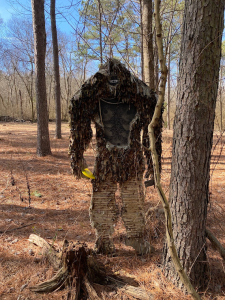
All three of my books (Nature Based Leadership; Nature-Inspired Learning and Leading; Weaned Seals and Snowy Summits) present compilations of personal experiences expressing my (and co-author Dr. Wilhoit for Weaned Seals and Snowy Summits) deep passion for Nature. All three books offer observations and reflections on my relationship to the natural world… and the broader implications for society. Order any and all from your local indie bookstore, or find them on IndieBound or other online sources such as Amazon and LifeRich.

